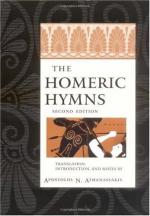{138} Such sandals are used to hide their tracks by Avengers of Blood among the tribes of Central Australia.
{140} This piece of wood is that in which the other is twirled to make fire by friction.
{141a} Otherwise written and interpreted, “as even now the skins are there,” that is, are exhibited as relics.
{141b} “Der Zweite Halbvers is mir absolut unverstandlich!”—Gemoll.
{144} This is not likely to be the sense, but sense the text gives none. Allen, Journal of Hellenic Studies, xvii. II.
{153} “As if one walked with trees instead of feet.”—Allen.
{156} The passage which follows (409-414) is too corrupt to admit of any but conjectural rendering. Probably Apollo twisted bands, which fell off Hermes, turned to growing willows, and made a bower over the kine. See Mr. Allen, op. cit.
{162a} This passage is a playing field of conjecture; some taking [Greek text] = Mediator, or Go-between: some as = pactum, “covenant.”
{162b} There seems to be a reference to the caduceus of Hermes, which some have compared to the forked Divining Rod. The whole is corrupt and obscure. To myself it seems that, when he gave the lyre (463-495), Hermes was hinting at his wish to receive in exchange the gift of prophecy. If so, these passages are all disjointed, and 521, with what follows, should come after 495, where Hermes makes the gift of the lyre.
{164} It appears from Philochorus that the prophetic lots were called thriae. They are then personified, as the prophetic Sisters, the Thriae. The white flour on their locks may be the grey hair of old age: we know, however, a practice of divining with grain among an early agricultural people, the Hurons.
{168} Hestia, deity of the sacred hearth, is, in a sense, the Cinderella of the Gods, the youngest daughter, tending the holy fire. The legend of her being youngest yet eldest daughter of Cronos may have some reference to this position. “The hearth-place shall belong to the youngest son or daughter,” in Kent. See “Costumal of the Thirteenth Century,” with much learning on the subject, in Mr. Elton’s “Origins of English History,” especially p. 190.
{170} Shielings are places of summer abode in pastoral regions.
{180} Reading [Greek text], Mr. Edgar renders “no longer will my mouth ope to tell,” &c.
{194} [Greek text] seems to answer to fauteuil, [Greek text] to [Greek text].
{196} M. Lefebure suggests to me that this is a trace of Phoenician influence: compare Moloch’s sacrifices of children, and “passing through the fire.” Such rites, however, are frequent in Japan, Bulgaria, India, Polynesia, and so on. See “The Fire Walk” in my “Modern Mythology.”
{204} An universally diffused belief declares that whosoever tastes the food of the dead may never return to earth.




